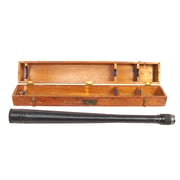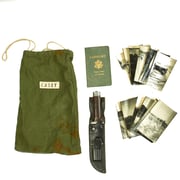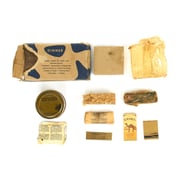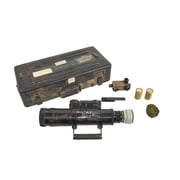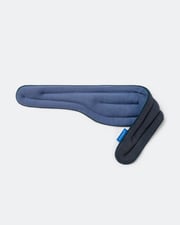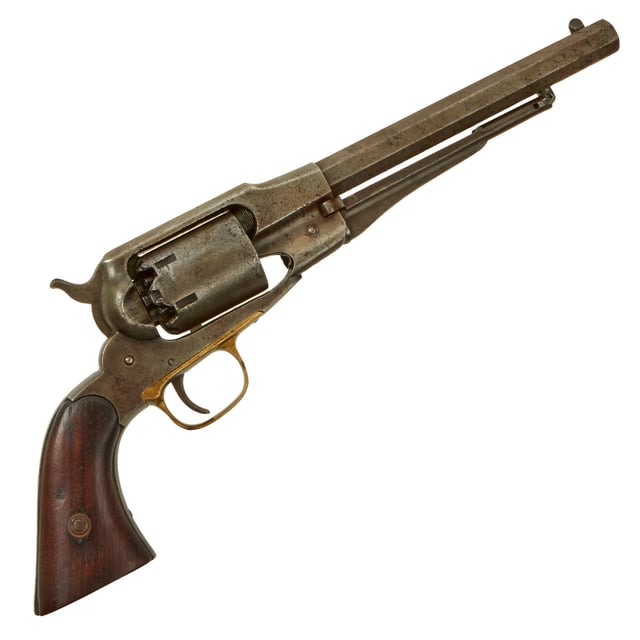
 International Military Antique
International Military AntiqueOriginal U.S. Indian Wars Era Remington New Model 1863 Navy .36cal Percussion Revolver - Serial 41255
USD 1995.00
Description
Original Item: Only One Available. This is a nice Remington New Model Navy Revolver in .36 caliber percussion, 6 shot single action revolver, with an 7 1/2-inch octagon barrel. It was produced some years after the Civil War, and most likely saw long use on the frontier during the "Indian Wars" era of U.S. History. These were often called the Model 1858 due to the patent dates, but production of this revision started in 1863, and the "New Model Navy" is the correct designation from Remington. The top of the octagonal barrel still has the original barrel markings, which partly illegible due to oxidation and wear: PATENTED SEPT. 14. 1858 E. REMINGTON & SONS. ILION. NEW YORK. U.S.A. NEW - MODEL The "NEW MODEL" stamping on these was a different die, so like many we see, this line is very faint, however close examination with a magnifier and light will show that it is definitely there. This revolver has matching serial number 41255 appearing on the underside of the barrel and on the frame under the grip, while the rear of the cylinder is unmarked. Unlike Colt, Remington did not always number every component of their guns, especially the cylinder. Also the company sold extra cylinders, as the arbor pin was easily removable, allowing a spare loaded cylinder to be quickly fit into the revolver. This means that there is not really any way to tell if this is the original cylinder or not. This 1863 Navy model revolver is in nice used condition showing a lovely worn patina, with some areas of past pitting. Original markings on the barrel are present, but definitely worn. The walnut grips are in very good condition, and look to have been refinished at some point. The ferrules are original, however the cross screw has been replaced, and a new nut is fitted inside the brass ferrule. The loading lever still locks into place correctly, and the cylinder arbor pin pulls out relatively easily, though it does look to be a replacement and can take some effort to remove. The revolver has a strong smooth action, with a strong mainspring, accurate indexing, and good cylinder lockup. We did not notice any of the finicky behavior that we often see on revolvers of this age. We checked the bore, and it is in good condition, still showing rifling, but also a lot of past fouling and oxidation, which has made it mostly dark. The remains of the rifling are worn, and the grooves are also quite dark, so this revolver looks to have been used extensively on the frontier. We checked the cylinder, and all six cap nipple cones are intact and clear, showing wear and oxidation on the exterior from use. Fully cleaned and ready to display, this is would make a worthy addition to any "Old West" collection. Ready to display! Specifications: Year of Manufacture: mid 1870s Caliber: .36cal Ammunition Type: Cap and Ball Barrel Length: 7 1/2 inches Overall Length: 13 1/2 inches Action: Single Feed System: 6 Shot Revolver History of Remington New Model Navy Revolver: Remington, like Colt, was in business of arms making long prior to the Civil War. They had been producing handguns since 1857 when they introduced the Remington Beals Pocket Revolver. With the outbreak of the Civil War all of the company's energy became devoted to the military production of longarms and hand guns. The martial hand guns produced during the Civil War period included the Remington-Beals Army and Navy Model revolvers, the Remington Models 1861 Army and Navy Revolvers, (a.k.a. as the "Old Model Army" and "Old Model Navy") and the Remington New Model 1863 Army and Navy revolvers. The Navy Revolvers switched to the "New Model" around serial number 23,000, and were produced long after the Civil War, probably until around 1880. Records of shipments to the Bureau of Ordnance (Navy) stop in December of 1865 at serial number 33,600, so generally revolvers under serial number 27,000 are considered to be Civil War production. Production finally ended circa 1888 at around serial number 45,000. The Remington is a single-action, six-shot, percussion revolver produced by E. Remington & Sons, Ilion, N.Y., based on the Fordyce Beals patent of September 14, 1858 (Patent 21,478). The Remington Army revolver is large-framed revolver in .44 caliber with an 8-inch barrel length. The Remington Navy revolver is slightly smaller framed than the Army and in .36 caliber with a 7.375 inch [Beals Navy 7.5 inch] barrel length. There were three progressive models made: the Remington-Beals Army & Navy (1860–1862), the 1861 Army & Navy (1862–1863), and the New Model Army & Navy (1863–1875). The three models are nearly identical in size and appearance. Subtle but noticeable differences in hammers, loading levers, and cylinders help identify each model. The 1861 Remington actually transitioned into New Model appearance by late 1862, slowly transforming throughout 1862, due to continual improvement suggestions from the U. S. Ordnance Department The New Model 1863 Navy was the last of Remington's .36 caliber percussion revolvers. Remington Armies were used from the beginning to the end of the Civil War in all fields. They were considered to be among the finest martial handguns of the day. The Remington New Model 1863 Army and it's forbear, the Remington-Beals Army, also saw action during the war. NOTE: International orders of antique firearms MUST be shipped using UPS WW Services (courier). USPS Priority Mail international will not accept these. International customers should always consult their country's antique gun laws prior to ordering.
International Military Antique deal
You could save on International Military Antique Original U.S. Indian Wars Era Remington New Model 1863 Navy .36cal Percussion Revolver - Serial 41255 with a International Military Antique promo code:
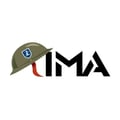
5% off
worked 5 days ago
